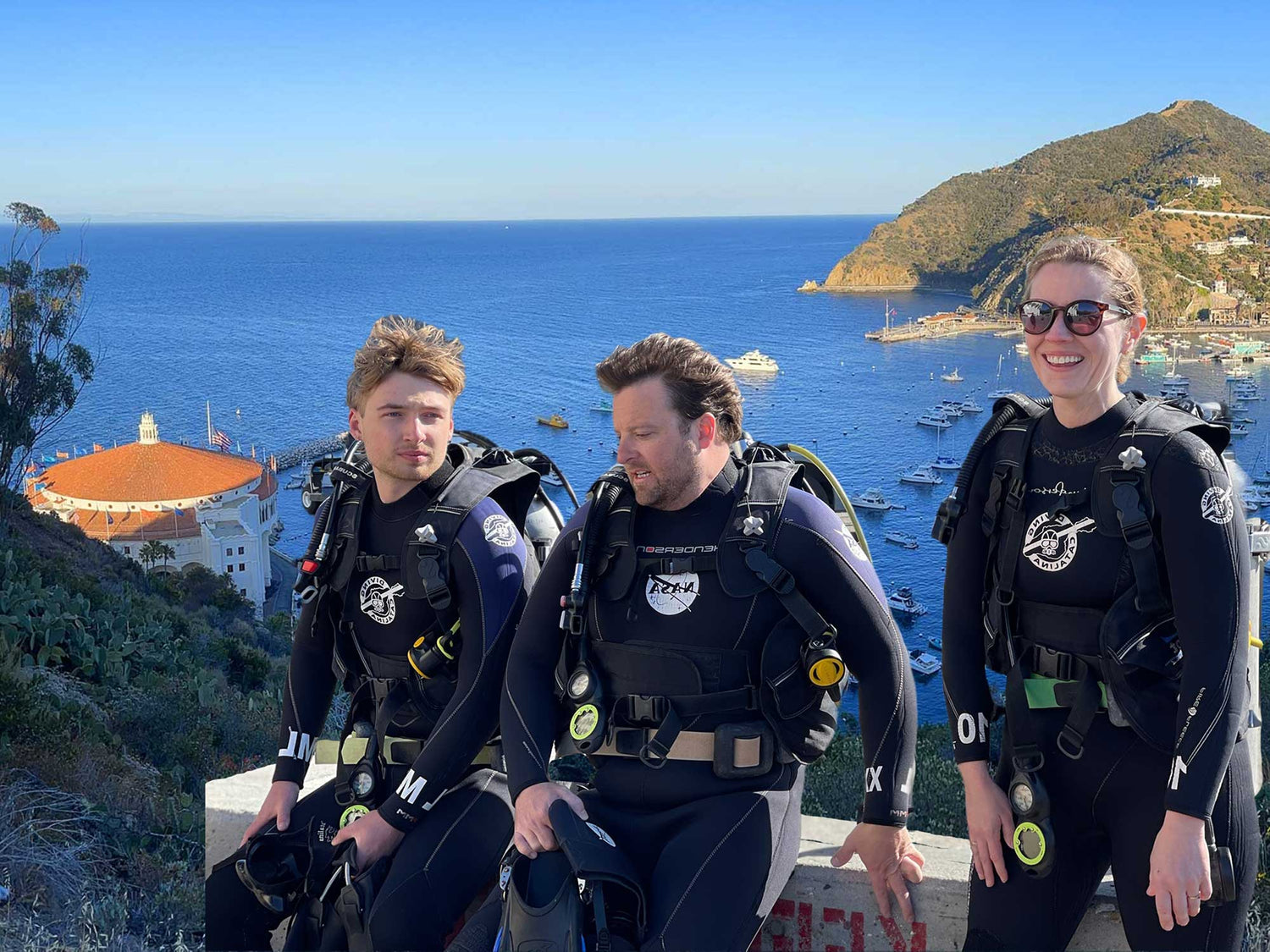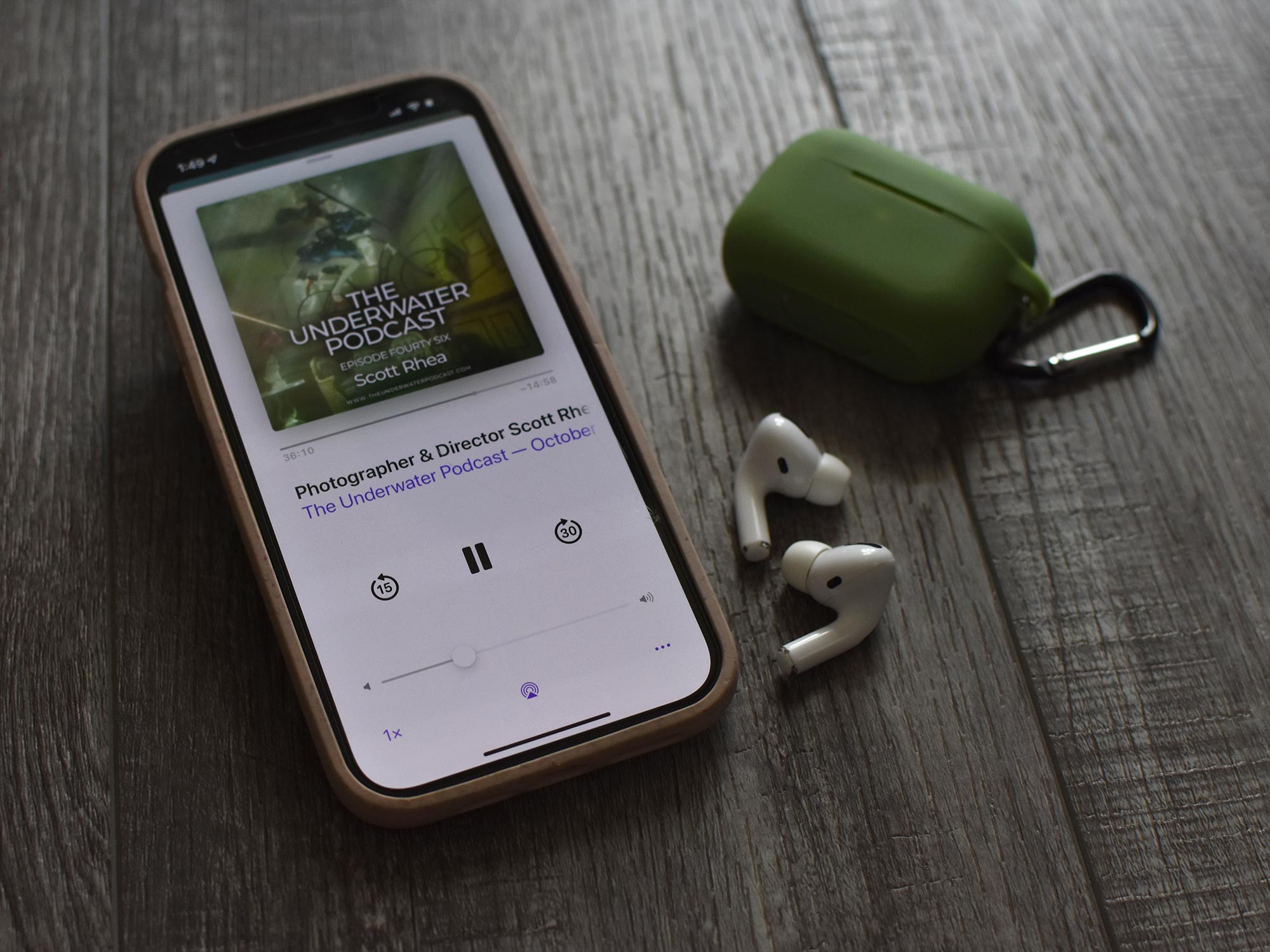Catalina Island is a little slice of heaven. It's the southernmost island of California’s Channel Islands and although it is only 22 miles south-southwest of Los Angeles it feels a world away. The island itself is 76 square miles but it packs a variety of flora, fauna, and endemic species into its valleys, cliffs, and coast lines. With its unique history, mild subtropical climate, and gorgeous views both topside and underwater, it’s any divers dream destination.

The rugged hills of Catalina Island provide opportunities for hiking if you're looking for another island adventure. © 2022 Gary Burns
Getting There
The Catalina Express ferry leaves at regular intervals throughout the day from Dana Point, Long Beach, and San Pedro. The ride is about 60-90 minutes depending on conditions and you can generally take any luggage you need without additional fees. The ferry arrives at the port of Avalon which is the only major town on the island of Catalina.

The kelp at Catalina Island can grow up to 14in (2.54cm) per day and are a big part of the magic of Catalina Island. © 2022 Gary Burns
Where to Stay
Catalina is close enough to the mainland that you could stay just about anywhere in the Los Angeles area and make a day trip over. Or for a more relaxing trip, book an AirBnB and stay a night or two. Homes to the northwest side of Avalon will be closer to the shore dive. Keep in mind that generally elevation increases quickly as you grow in distance from the water. Be prepared for some uphill walks as you move away from the center of town.
Getting Around
There are some cars, taxis, and shuttles on island but they are very limited. The primary mode of transportation is golf cart. We recommend securing a golf cart rental if you will be staying overnight on island and want to go back and forth to the dive entry at Casino Point.

California Sheephead are the purple and pink wrasse fish you'll see at Casino Point. © 2022 Gary Burns
Casino Point
In 1919 William Wrigley Jr., a chewing gum magnate, bought controlling shares of Catalina Island. Wrigley influenced much of the culture and construction of Catalina Island, most notably the construction of Catalina Casino. Opened in May of 1929, the Catalina Casino is the most prominent landmark on the island and serves as a center for arts and entertainment. The Dive Park was designed by Carl and Maggie Koehler in 1962 and was officially recognized three years later. It is the United States’ first ever nonprofit underwater dive park and its accessibility is what continues to make it such a popular site today.
There are several dive operators that have set up shop both inside the building at Casino Point and running out of vans and trucks. We can recommend Diving Catalina who can supply any rental gear you need, tanks, instruction, or tours.
During the summer you can expect water temperatures between 70-74°F (21-23°C) and 55-59° (12.7-15°C) in the winter. Visibility at the dive park can range anywhere from 15-100ft (4.5-30.48m), with an average visibility of 40ft (12.1m).
Most local divers were seen in semi-dry or dry suits, though 7mm wetsuits are comfortable – especially in the summer – and are the most common in rental gear.

There's a lot of action topside at the dive park too - on a busy day you'll see pelicans, great blue herons, not to mention plenty of divers and gear. © 2022 Denise Pietsch
While there are many tourists that walk around the Casino Point area throughout the day, scuba diving is the primary attraction there. It is a protected Marine Sanctuary defined by marker buoys and ropes strung around the surface. A wide set of stairs leads straight down into the water making for easy entry and exit even in choppy waters. Divers are allowed to gear up along the sea walls and benches and it’s generally acceptable to leave your belongings out while you’re in the water. It’s a friendly atmosphere and locals report that there’s little or no threat of theft. There are lockers available at the site to use for a fee and some operators have a lock box type arrangement.
If you bring friends or family who are non-divers, consider the Discover Scuba program which includes a 17-minute video and half-hour pre-dive briefing, and short dive to a maximum depth of 40 feet. Like most US Pacific coast diving, the water is cold with wave movements and limited visibility which can be overwhelming and disorienting. People with some level of comfort and experience swimming in ocean waters will do best and make the most out of the investment. Discover Diving courses tend to run around $100-130 plus tip, including the gear.
Alternatively, there is an option to snorkel the site. The shallows are warmer, more clear, and are teeming with marine life and kelp that has grown to the surface. Tons of garibaldi are easily visible from the shore and can be within arms reach even on snorkel.

A sea lion swims among the kelp forest. © 2022 Gary Burns
Scuba Diving
It is not necessary to have a permit to dive Casino Point but unless you’re bringing tanks from the mainland you will need to rent from a local operator. Try to get to the park early to avoid crowds.
A large site map is presented at the top of the stairs with compass lines and distances to most points of interest on the site. While it’s still possible to get disoriented among the kelp, natural navigation is easy by remembering that going shallower will take you towards shore. The shore will be on your left when swimming north and on your right when swimming south, with the stairs pretty much in the middle of the site.

The stairs at Casino Point Dive Park make entry and exit safe and easy. © 2022 Denise Pietsch
Sea Life at Catalina
Large kelp forests are a signature of Catalina diving. The kelp strands are beautiful monoliths that stretch from the ocean floor all the way to the surface. Be sure to keep your hoses clipped in and watch the lights on your system when swimming around. The kelp can easily get tangled on long light arms and in your dive gear.
Garibaldi are the state fish of California and impossible to miss on your dive off Casino Point. They swarm around the entry point and make you feel as if you’re entering a human size fishbowl. They are quite territorial especially when protecting nests of eggs. Every garibaldi is a vibrant bright orange color, and the juvenile garibaldi are even more garishly dressed with bright blue spots that tell other fish of the species not to mess with them.

Garibaldi are not shy and make for fantastic photography subjects. © 2022 Gary Burns
You can also see octopus, particularly around the pile-ons. At night they come out to hunt in large numbers. Lobsters, eels, black sea urchins, kelp fish, striped sea bass. Jellyfish in at least two varieties: egg yolk are the most common and moon jellies on occasion.
If you’re lucky you’ll see giant sea bass, and a variety of sharks including taupe sharks and horned sharks, and sea lions. The operators at the site are the best source to find out what’s been sighted most recently and may still be hanging out that day.
When carrying camera equipment it’s best to let your buddy hand your gear down to you rather than enter with it and avoid collision with the steps and/or rocks surrounding them. If you have no surface support on exit, you can assign one buddy to hold camera equipment while the other exits with their hands free to remove fins and get a good footing before lifting the camera gear to safety above the surf.

Eggyolk Jellyfish © 2022 Gary Burns
Surface Interval
If you’re trying maximize your shore diving time, it’s possible to stay at the site and piggy back dives without fully un-suiting. Drinks and snacks are close by. Showers and public restrooms are just a few hundred feet from the site.
When you’re ready to dry off and look civilized again, Avalon is full of locally-owned restaurants and bars, plus shopping and other activities. Kayaking and stand up paddle boarding are popular when winds are low and conditions are calm enough.

The Giant Sea Bass are another special creature to encounter at Catalina. These gentle giants can grow up to 6ft. (1.82m) long. © 2022 Gary Burns
Other Ways to Dive Catalina
There are about 100 dive sites around the perimeter of Catalina Island, with most accessible only by dive boat. Regular day charters leave from the coast of California’s mainland and make the crossing back and forth about 90-minutes each way with 3 dives in between. Boat operators have the benefit of being able to adjust course and pick sites based on the conditions of the moment. Expect to put a whole day into it with most charters leaving early in the morning and arriving back around dinner time.
 Jean Rydberg, daughter of Ike Brigham, became President & CEO of Ikelite in 2006. Prior to that, she wisely pursued a degree in Astronomy & Astrophysics to prepare herself for the challenges of running a technology-driven manufacturing business with global distribution. Jean fully embraces the need to travel outside of her hometown of Indianapolis to experience good diving. She believes that any camera is capable of amazing results in the right hands, and anyone can become a great photographer given the right advice. When she's not working she's spending time with her husband, cats, and two daughters (though not necessarily in that order).
Jean Rydberg, daughter of Ike Brigham, became President & CEO of Ikelite in 2006. Prior to that, she wisely pursued a degree in Astronomy & Astrophysics to prepare herself for the challenges of running a technology-driven manufacturing business with global distribution. Jean fully embraces the need to travel outside of her hometown of Indianapolis to experience good diving. She believes that any camera is capable of amazing results in the right hands, and anyone can become a great photographer given the right advice. When she's not working she's spending time with her husband, cats, and two daughters (though not necessarily in that order).
Want the easy way to improve your underwater photography? Sign up for our weekly newsletter for articles and videos directly in your inbox every Friday:
Additional Reading
Diving Catalina Island with the Canon R5 and R6 [VIDEO]
Garibaldi Underwater Camera Settings and Technique
Nikon Z6 II or Canon R6 Housing? Back in the Water in Catalina [VIDEO]
Kelp Forest Underwater Camera Settings and Technique
Customer Photos | Douglas Klug in California's Kelp Forests and Beyond












![Diving the Crack Between Continents | Silfra, Iceland [VIDEO]](http://www.ikelite.com/cdn/shop/articles/Silfra.jpg?v=1657221496&width=2000)
